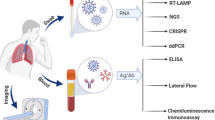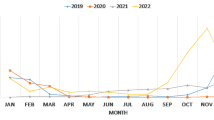Abstract
Acquired immunodeficiency syndrome (AIDS) caused by human immunodeficiency virus (HIV) is a major global public health problem. The aim of this study is to determine the prevalence of HIV-1 infection in four municipalities of Pará State (Marabá, Parauapebas, Curionópolis, and Canaã dos Carajás), in northern, Brazil. The municipalities are located in the Carajás Complex iron mining area. The employment opportunities result in extensive migratory flow of people. A total of 4771 serum samples were obtained from 2005 to 2014 and were sent to Evandro Chagas Institute, Belém-Pará, where they were tested by enzyme-linked immunosorbent assay, with reactive samples confirmed by Western blot analysis. The samples were from individuals from 23 Brazilian states and the Federal District, mainly Maranhão (39.53%) and other municipalities of Pará (34.25%). The total positivity rate was 0.48% (23/4771). The rate was 0.47% (14/2975) in males and 0.50% (9/1796) in females. Of these, 0.33% (14/4275) were from asymptomatic individuals whose serum were collected during the serological survey, 1.81% (9/497) were from cases featuring clinical symptoms including fever/diarrhea/jaundice, which were included in febrile, diarrheal, and icteric syndromes analyzed during the study. The findings indicated the presence of HIV-1 infection in the general population studied. The majority of cases (60.9%, 14 of 23 positive cases) were asymptomatic.

Similar content being viewed by others
References
Nyamweya S, Hegedus A, Jaye A, Rowland-Jones S, Flanagan KL, Macallan DC (2013) Comparing HIV-1 and HIV-2 infection: lessons for viral munopathogenesis. Rev Med Virol 23:221–240
Castro SS, Scatena LM, Miranzi Neto A, Camargo FC, Nunes AA. (2018). HIV/AIDS case definition criteria and association between sociodemographic and clinical aspects of the disease reported in the state of Minas Gerais from 2007 to 2016. Rev Soc Bras Med Trop 51: 4 Uberaba
World Health Organization (WHO) (2016) Consolidated guidelines on the use of antiretroviral drugs for treating and preventing HIV infection
Boletim Epidemiológico HIV/Aids Secretaria de Vigilância em Saúde | M.S Número Especial | Dez. 2019
Luz PM, Veloso VG, Grinsztejn B (2019) The HIV epidemic in Latin America accomplishments and challenges on treatment and prevention. Curr Opinion in HIV and AIDS 14(5):366–373
Instituto Brasileiro de Geografia e Estatística (IBGE), acesso em 17-10-2019, https://cidades.ibge.gov.br/brasil/pa/canaa-dos-carajas/curionopolis/maraba
Ayres M, Ayres Junior M, Ayres DL, Santos AS (2007) BioEstat. 5.0. Aplicações estatísticas nas áreas das ciências biológicas e médicas. Belém, p 364
Brasil (2018) Ministério da Saúde (MS). Boletim Epidemiológico Secretaria de Vigilância em Saúde. In: V49 #53
Mangal TD, Pascom ARP, Vesga JF, Meireles MV, Benzaken AS, Hallett TB (2019) Estimating HIV incidence from surveillance data indicates a second wave of infections in Brazil. Epidemics 27:77–85
Herout S, Mandorfer M, Breitenecker F, Reiberger T, Grabmeier-Pfistershammer K, Rieger A, Aichelburg MC (2016) Impact of early initiation of antiretroviral therapy in patients with acute HIV infection in Vienna, Austria. PLoS One 11(4):e0152910
Laanani M, Ghosn J, Essat A, MeLard A, Seng R, Gousset M, Panjo H et al (2015) Agence Nationale de recherché Sur le Stda PRIMO cohort study group impact of the timing of initiation of Atiretroviral therapy during primary HIV-1 infection on the decay of cell-associated HIV-DNA. Clin Infect Dis 1 60(11):1715–1721
Caro-Vega Y, Belaunzarán-Zamudio PF, Crabtree-Ramirez B, Shepherd BE, Mejia F, Giganti MJ, Paterson P et al (2018) Trends in proportion of older HIV-infected people in care in Latin América and the Caribbean: a growing challenge. Epidemiol Infect 146(10):1308–1311
Santos AFM, Assis M (2011) Vulnerabilidade das idosas ao HIV/AIDS: despertar das políticas públicas e profissionais de saúde no contexto da atenção integral: revisão de literatura. Rev Bras Geriatr Gerontol 4(1):147–157
Vallinoto ACR, Aguiar S, Sá KG, Freitas FB, Ferreira G, Lima SS (2016) Prevalence and risk behaviour for human immunodeficiency virus 1 infection in Marajó Island, northern Brazil. Ann Hum Biol 43(4):397–404
Henry J Kaiser Family Foundation (KFF) access 07 15 2019. Available from https://www.kff.org/global-health-policy/fact-sheet/the-global-hivaids-epidemic/
De Munter P, Derdelinckx R, Peetermans WE, Vanderschueren S, Van WE (2017) Clinical presentation, and causes febrile episodes of outcome in a prospective cohort of HIV infected patients. Infect Dis (Lond) 49(1):65–70
Lambertucci JR, Avila RE, Voieta I (2005) Fever of unknown origin in adults. J Braz Soc Trop Med 38(6):507–513
UNAIDS. AIDSinfo. 2017 [cited August 2017]. Available from: http://aidsinfo.unaids.org
Acknowledgments
We are grateful to Sr. Lindomar Vasconcelos and the entire field staff that helped with the collection of serum samples and clinical data used in the present study. We thank the valuable technical support provided by Celina Freitas and Dielle Teixeira; as well as the Geoprocessing Laboratory (LABGEO), especially to the technician Clístenes Pamplona Catete, for the elaboration of the mapping of the study region, and Sr. Afonso Alves for spreadsheet. Special thanks to all the persons who participated in this study.
Funding
This research was supported by Vale do Rio Doce Company and Evandro Chagas Institute (IEC), and the payment of English review was done by the Virology Pós-Graduation Program of IEC.
Author information
Authors and Affiliations
Corresponding author
Ethics declarations
Conflict of interest
The authors declare that they have no conflict of interest.
Additional information
Responsible Editor: Giliane Souza Trindade
Publisher’s note
Springer Nature remains neutral with regard to jurisdictional claims in published maps and institutional affiliations.
Rights and permissions
About this article
Cite this article
Macêdo, O., Freitas, F.B., dos Reis, R.M. et al. Prevalence and epidemiological characteristics of human immunodeficiency virus-1 infection in an iron mining area with intense migratory flow in Pará State, Brazilian amazon, 2005–2014. Braz J Microbiol 51, 1737–1745 (2020). https://doi.org/10.1007/s42770-020-00361-7
Received:
Accepted:
Published:
Issue Date:
DOI: https://doi.org/10.1007/s42770-020-00361-7




